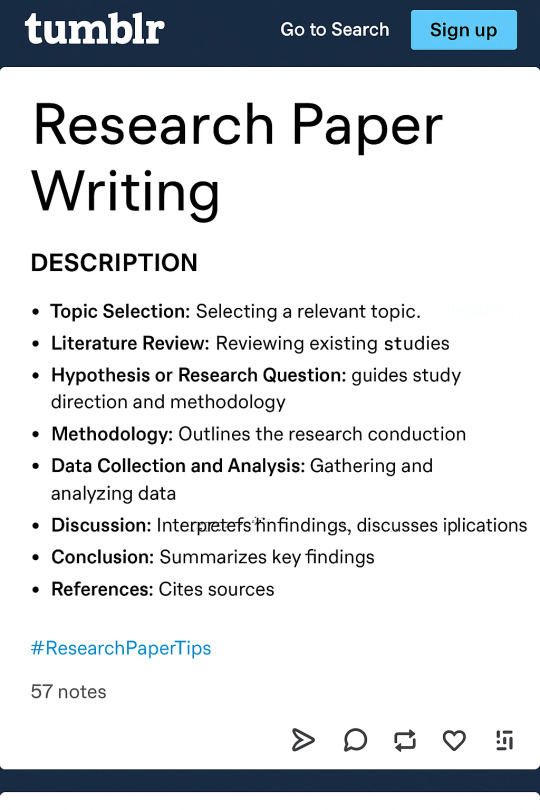#ResearchPaperStructure
Explore tagged Tumblr posts
Text

#ResearchPaperWriting#AcademicWriting#LiteratureReview#ResearchMethodology#DataAnalysis#ResearchPaperTips#ThesisWriting#HypothesisFormulation#ResearchProcess#WritingTips#AcademicResearch#ResearchPaperStructure#ScientificWriting#ScholarlyWriting#PaperWriting#WritingSkills#ResearchStudy#StudentWriting#EssayWriting#ResearchPaperHelp
2 notes
·
View notes
Text
Research Paper Writing & Publishing - Ready Made Projects
Research Paper Writing & Publishing Paper Publication In last 10 years btech projects supported 1000’s of scholars and students to publish their papers in specified journals. We include a team of proficient writers with high expertise in relevant fields to deliver the best written research papers tailored to meet the standards and specifications.
0 notes
Text
Research Paper Writing & Publishing - Ready Made Projects
Research Paper Writing & Publishing Paper Publication In last 10 years btech projects supported 1000’s of scholars and students to publish their papers in specified journals. We include a team of proficient writers with high expertise in relevant fields to deliver the best written research papers tailored to meet the standards and specifications.
0 notes
Text
Unraveling the Structure of Scientific Paper Writing
Scientific paper writing is an intricate process that serves as the backbone of academic communication. As scholars strive to share their findings with the global scientific community, mastering the art of structuring a scientific research paper becomes paramount. In this blog, we will delve into the essential elements that constitute the structure of scientific writing, highlighting the key components that contribute to a coherent and impactful paper.

Understanding the Structure of Scientific Writing
Title and Abstract: The Gateway to Your Research
The journey into a scientific paper begins with a captivating title and a concise abstract. These elements play a pivotal role in attracting readers and providing a snapshot of the study. The title should be informative, engaging, and reflective of the research's core focus. Meanwhile, the abstract succinctly outlines the objectives, methods, results, and conclusions of the study.
Introduction: Setting the Stage
The introduction serves as the foundation of the scientific paper, presenting the research problem, its significance, and the overarching goals. It concludes with the research hypothesis or questions, creating a roadmap for readers to follow. A well-crafted introduction not only informs but also captivates the audience, compelling them to delve deeper into the paper.
Literature Review: Contextualizing Your Research
The literature review establishes the context of the study by reviewing existing research relevant to the topic. It showcases the gaps in knowledge that the current research aims to fill and provides a theoretical framework for understanding the research problem. Effective integration of existing literature strengthens the paper's credibility and demonstrates the researcher's awareness of the field.
Methodology: Unveiling the Research Design
This section details the methods employed to collect and analyze data. It should be comprehensive enough for another researcher to replicate the study. From the experimental design to data collection and statistical analysis, transparency and precision are paramount. Clarity in methodology ensures the validity and reliability of the study, fostering trust among peers.
Results: Data Unveiled
Presenting the findings is a critical aspect of a scientific paper. Results should be presented objectively, using tables, figures, and graphs to enhance clarity. A detailed narrative should accompany these visual aids, explaining the significance of each result. Avoid interpretation at this stage, focusing solely on presenting the raw data.
Discussion: Interpreting the Findings
The discussion section is where the researcher interprets the results in the context of the study's objectives and relevant literature. It is essential to highlight patterns, correlations, and discrepancies and discuss their implications. Acknowledge limitations and propose avenues for future research. A well-structured discussion demonstrates the researcher's analytical prowess and the ability to draw meaningful conclusions.
Conclusion: Summing Up the Journey
The conclusion reiterates the key findings and their implications, providing a concise summary of the study. Avoid introducing new information in this section; instead, focus on reinforcing the study's contributions and their broader implications for the field.
References: Giving Credit Where It's Due
Accurate citation is crucial in scientific writing. The references section provides a comprehensive list of all sources cited in the paper. Follow the citation style specified by the target journal to ensure consistency and adherence to academic standards.
Acknowledgments: Recognizing Contributions
The acknowledgments section allows researchers to express gratitude for any assistance received during the study. This can include funding sources, technical support, or input from colleagues. While not mandatory, acknowledging contributions enhances the paper's transparency and the researcher's credibility.
Appendices: Supplementing Information
Complex data sets, additional details on methodology, or supplementary materials can be included in the appendices. This section is optional but provides an opportunity to offer in-depth information without cluttering the main body of the paper.

Structure of Scientific Writing
Understanding the structure of scientific paper writing is fundamental for researchers aiming to communicate their findings effectively. A well-organized paper enhances readability and ensures that the research is presented in a logical and coherent manner.
Structure of Scientific Research Paper
The structure of a scientific research paper follows a standardized format, comprising distinct sections that collectively convey the research process and findings. Mastering this structure is essential for researchers to navigate the intricate world of academic publishing.
Scientific Paper Writing Services
For those navigating the complexities of scientific paper writing, professional services can provide invaluable assistance. Scientific paper writing services offer support in crafting well-structured, clear, and impactful papers, ensuring that research is effectively communicated to the intended audience.
Conclusion
In the intricate tapestry of scientific writing, each section plays a vital role in ensuring the clarity, credibility, and impact of the research. Researchers must navigate through the intricacies of each component, weaving a narrative that not only communicates their findings but also contributes meaningfully to the broader scientific discourse. As we unravel the structure of scientific paper writing, we equip ourselves with the tools to convey the fruits of our labor to the global scientific community with precision and impact.
#ScientificWriting#ResearchPaperStructure#AcademicCommunication#PaperWritingTips#ScientificResearch#WritingCommunity#AcademicPublishing#ResearchMethodology#ScholarlyWriting#ScienceCommunication#ResearchFindings#LiteratureReview#DataAnalysis#ResearchJourney#CiteYourSources#AcademicStandards#PaperStructure#WritingServices#ResearchInsights#PeerReviewProcess
0 notes